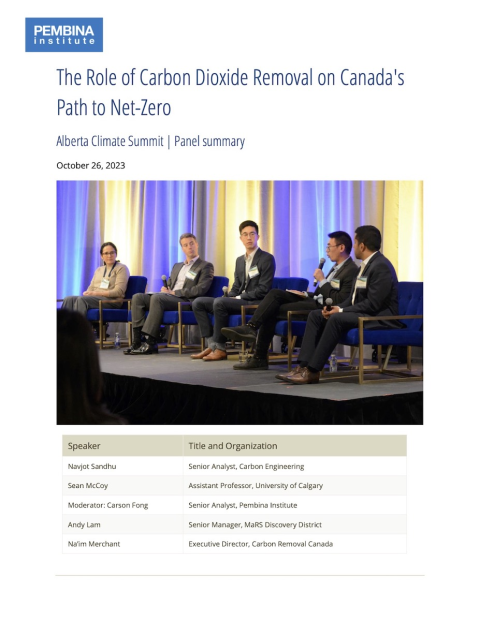At the 2023 Alberta Climate Summit, this panel of key stakeholders in the carbon dioxide removal (CDR) ecosystem in Canada explored how CDR fits within Canada’s net-zero strategy as well as important considerations for CDR deployment.
Panel consisted of:
- Navjot Sandhu - Senior Analyst, Carbon Engineering
- Sean McCoy - Assistant Professor, University of Calgary
- Andy Lam - Senior Manager, MaRS Discovery District
- Na’im Merchant - Executive Director, Carbon Removal Canada
- Moderator: Carson Fong - Senior Analyst, Pembina Institute
Here is a summary of some points made during the discussion:
In Canada’s net-zero strategy, CDR can target legacy emissions, but shouldn’t be considered a silver bullet. Legacy emissions are those that have already been released into the atmosphere. Emissions reduction efforts need to continue without delay — the more that can be reduced, the fewer remaining emissions there will be. The promise of a new CDR solution in the future cannot let us delay reductions now.
Most CDR technologies are early in development and need rapid progress to ensure future viability. One panelist estimated that CDR is 20 years behind CCUS in maturity. A main theme of the discussion was building a path towards large-scale deployment, starting with small first-of-its-kind facilities. Iterative development and learning-by-doing could bring down the high costs seen today. It was noted that the costs vary widely depending on the method of carbon removal. Programs like Mission to MaRS: Carbon Management aim to increase the chance of success of projects across this diversity of technologies by supporting new ventures developing emerging technologies. Some made-in-Canada solutions are already making rapid progress within the program, including:
- TerraFixing, a method of direct air capture that works best in cold climates
- Planetary, an ocean alkalinity enhancement method
- CarbonRun, a river-based removal method.
The standards on how to deploy CDR effectively and responsibly need to be created. In order to avoid environmental and social consequences in the future, the impacts of the various CDR technologies need to be understood now while deployment is still relatively small. There are questions around whether communities will allow changes in landscape that will come along with many types of CDR. Strong life cycle assessment and transparent monitoring systems can help provide rigour and confidence to the measurement of carbon removal. Key areas of focus of the CanCO2Re research project, an interdisciplinary research initiative examining the role of CDR deployment in meeting Canada’s net-zero targets, include life cycle assessments of various CDR technologies and an analysis of the unintended consequences of CDR deployment.
Governments and corporates play key roles in scaling CDR. While some forms of CDR have applications for the CO2 that can generate revenue, funding long duration storage of carbon dioxide will require a different model. Eventually, compliance and regulatory regimes can take CDR to the next level. But this will take time, so until then, the voluntary market can drive progress. Companies like Shopify are buying carbon removal to help signal demand in the market, and eventually count against their company emissions. These advanced commitment purchases help CDR projects access financing and directly support the scale-up of these technologies. Aside from structuring compliance regimes that require CDR to take place, governments can also play a role as a buyer of CDR. This could be a strong signal of legitimacy to the market and help with price discovery.
Canada has the right ingredients to be a leader in CDR. Canada has access to clean electricity, a skilled, relevant workforce and research capability. Alberta is a great place for some types of CDR, with great storage resources and transferrable expertise. In Quebec, extensive mine tailings can be used for mineralization. The coastal provinces have great access for ocean-based methods. A pan-Canadian strategy that matches the diversity of CDR methods to regional strengths could accelerate large-scale deployment. Carbon Removal Canada is working with all stakeholders to make CDR growth a reality.
Strong policies are needed to drive large-scale development in Canada. Carbon Engineering, though founded in Canada, is building its first full-scale plant in the United States because of the country’s strong policy environment. To ensure rapid and responsible deployment in Canada, we need competitive, clear and transparent policies. Moving too slowly or timidly on this will result in continued capital flow into the United States. So far, however, there has been relatively good progress in Canada. It’s encouraging to see CDR recognized in the recent carbon management strategy as well as the ongoing development of a protocol to recognize direct air capture removals. Through these sorts of mechanisms, government can help create strong standards.








